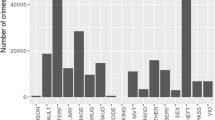Abstract
Identification of influential parameters using data mining and statistical tools is an important subject of criminology. These parameters are further used in criminal prediction and crime reduction which is a well-known problem in law enforcement agencies. In this research, we have analyzed the 5 years data of the Prison Department of the Government of KP. More than thirty parameters related to criminals were cleaned, preprocessed and analyzed. Correlation of these parameters with high act crimes was identified. There are five parameters which have strong correlation with high act crimes that includes total number of group members, recovery of assets, total number of hearings, crime frequency, and total number of non-blood visitors. On the other hand, there are three parameters that have negative correlation with high act crimes which includes education level of a criminal, total number of dependents, and prison duration. The overall objective of this research is to identify influential parameters related to high category crimes and support the law enforcement agencies of the KP province in reducing the crime ratio.








Similar content being viewed by others
References
Aghababaei, S. , Makrehchi, M.: Mining Social Media Content for Crime Prediction, in IEEE/WIC/ACM International Conference on Web Intelligence (WI), IEEE, 2016, pp. 526–531. IEEE
Brame, R., Piquero, A.R.: Selective attrition and the age-crime relationship. J. Quant. Criminol. 19(2), 107–127 (2003)
Brantingham, P.J., Brantingham, P.L.: Environmental Criminology. Sage, Thousand Oaks (1981)
Claro, H.G., Oliveira, M.A.F.D., Bourdreaux, J.T., Fernandes, I.F.D.A.L., Pinho, P.H., Tarifa, R.R.: Drug use, mental health and problems related to crime and violence: cross-sectional study. Revista latino-americana de enfermagem 23(6), 1173–1180 (2015)
Ellis, L., Beave, K.M., Wright, J.: Handbook of Crime Correlates. Academic Press, Cambridge (2009)
Enamorado, T., López-Calva, L.F., Rodríguez-Castelán, C.: Crime and growth convergence: evidence from mexico. Econ. Lett. 125(1), 9–13 (2014)
Eriksson, K.H., Hjalmarsson, R., Lindquist, M.J., Sandberg, A.: The importance of family background and neighborhood effects as determinants of crime. J. Popul. Econ. 29(1), 219–262 (2016)
Frank, R.: SPORS: A Suspect Recommendation System Based on Offenders’ Reconstructed Spatial Profile. In: European Intelligence and Security Informatics Conference (EISIC), IEEE, pp. 38–45. IEEE (2012)
Gould, E.D., Weinberg, B.A., Mustard, D.B.: Crime rates and local labor market opportunities in the United States: 1979–1997. Rev. Econ. Stat. 84(1), 45–61 (2002)
Li, X., Juhola, M.: Country crime analysis using the self-organising map, with special regard to economic factors. Int. J. Data Mining, Model. Manag. 7(2), 130–153 (2015)
Mande, U., Srinivas, Y., Murthy, J.: An intelligent analysis of crime data using data mining & auto correlation models. Int. J. Eng. Res. Appl. (IJERA) 2(4), 149–153 (2012)
Nasridinov, A., Park, Y.-H.: Crime hotspots analysis in South Korea: a user-oriented approach. Adv. Sci. Technol. Lett. 52, 81–85 (2014)
Nikolic-Ristanovic, V.: Making people happy is the best crime prevention: towards happy-making criminology. Eur. J. Criminol. 11(4), 401–409 (2014)
Nolan, J.J.: Establishing the statistical relationship between population size and ucr crime rate: its impact and implications. J. Crim. Justice 32(6), 547–555 (2004)
Palmer, G.L.: Forensic analysis in the digital world. Int. J. Digital Evid. 1(1), 1–6 (2002)
Ranson, M.: Crime, weather, and climate change. J. Environ. Econ. Manag. 67(3), 274–302 (2014)
Steffensmeier, D.J., Allan, E.A., Harer, M.D., Streifel, C.: Age and the distribution of crime. Am. J. Sociol. 94(4), 803–831 (1989)
Vineeth, S.K., Pandey, A., Pradhan, T.: A novel approach for intelligent crime pattern discovery and prediction. In: Advanced Communication Control and Computing Technologies (ICACCCT), 2016 International Conference on, pp. 531–538. IEEE (2016)
Ying, Z.: Analysis of Crime Factors Correlation Based on Data Mining Technology, In: International Conference on Robots & Intelligent System (ICRIS), IEEE, pp. 103–106. IEEE (2016)
Author information
Authors and Affiliations
Corresponding author
Rights and permissions
About this article
Cite this article
Wadood, D., Rauf, A., Khusro, S. et al. Identifying key influential parameters of high profile criminals through statistical correlation. Cluster Comput 22 (Suppl 3), 7135–7148 (2019). https://doi.org/10.1007/s10586-017-1059-1
Received:
Revised:
Accepted:
Published:
Issue Date:
DOI: https://doi.org/10.1007/s10586-017-1059-1




